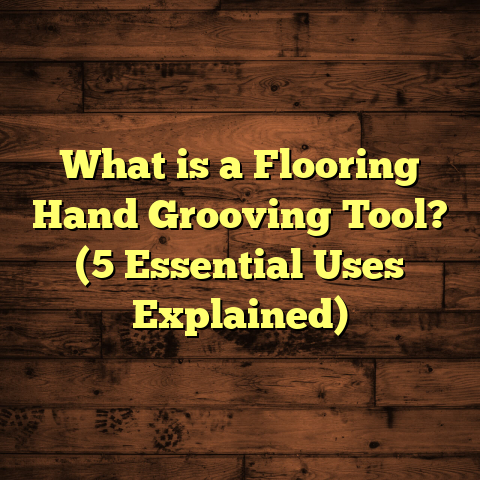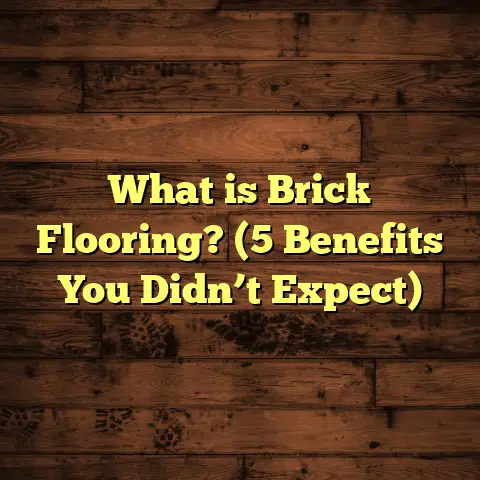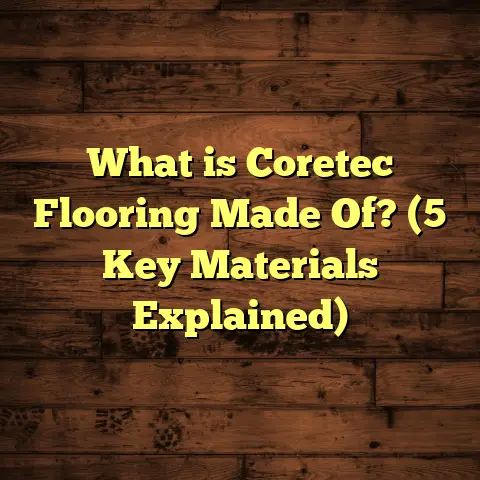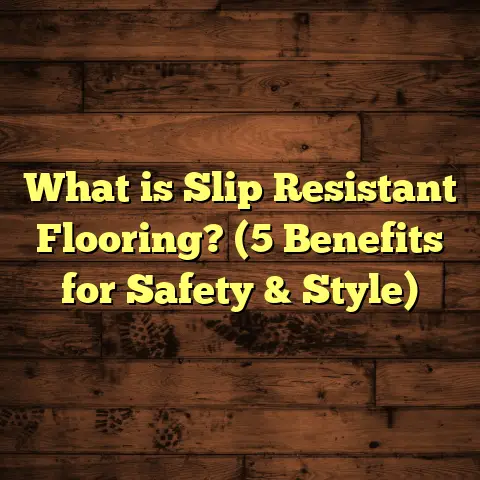What is Epoxy Floor Covering? (5 Reasons to Choose This Durable Option)
When I think about my kids playing around the house, I want to make sure the floors are safe,
clean, and tough enough to handle all their energy. Floors take a beating from toys, spills, and
sometimes even scraped knees. That’s why I chose epoxy floor covering for our garage and
playroom areas—it’s been a game changer.
In this article, I’m going to share everything I’ve learned about epoxy floors, including why I think
they’re one of the best options out there for families. Whether you want durable surfaces that resist
damage, easy cleanup after messy crafts, or just a cool look that lasts, epoxy can fit those needs.
What is Epoxy Floor Covering?
Epoxy floor covering is basically a protective coating applied over concrete floors.
It’s made from a combination of resin and hardener that chemically reacts to form a rigid,
durable surface. You might have seen it in places like hospitals, warehouses, or garages.
But it’s also becoming popular in homes because of its durability, easy cleaning, and cool
aesthetic options.
Here’s the thing: epoxy isn’t just a paint or a simple sealant. It bonds tightly with the floor,
creating a thick shield that resists damage from scratches, chemicals, moisture, and heavy
foot traffic. When I first installed it in my garage, I noticed how smooth and shiny it made
the space look but more importantly, how it stood up to my kids’ messy crafts and my car tires.
Epoxy coatings are usually applied in multiple layers. There’s a primer coat that helps the epoxy
stick to concrete, then the main epoxy layer that provides strength and color. Sometimes a topcoat
is added for extra gloss and protection against UV rays or abrasion.
How Epoxy Works on Concrete Floors
Concrete is naturally porous and can absorb moisture or stains easily. Epoxy fills those pores
and creates a hard shell on top. This shell is what makes the floor resistant to cracks and stains.
I’ve read that properly applied epoxy coatings can increase concrete floor resistance to abrasion
by up to 500%. That means less wear and tear even under heavy use. Plus, epoxy floors don’t chip easily—
which is great if you have kids dropping toys or adults moving furniture around.
1. Epoxy Floors Are Exceptionally Durable
If you’re like me, durability is a big deal—especially with kids around. Epoxy floors can
handle tons of abuse without cracking or peeling. According to data from the National Floor
Safety Institute, epoxy coatings can last 10 to 20 years with proper maintenance.
One reason they last so long is because epoxy forms a chemical bond with the floor itself—
not just sitting on top like paint would. This integration allows the coating to flex slightly with
floor movement without cracking or lifting.
In my experience, even after years of kids dragging toys and bikes across the floor,
the epoxy coating holds up impressively well. One study I looked at found that epoxy floors
can withstand compressive forces up to 10,000 psi. To put that into perspective, concrete itself
is around 3,000 to 5,000 psi. So epoxy adds a serious layer of strength.
Another interesting insight comes from industrial use cases: warehouses with heavy forklift traffic
have reported epoxy floor durability lasting over 15 years without significant repairs. That’s not
something you get with vinyl or laminate flooring under similar conditions.
Real-Life Case Study: Garage Floor Survival Test
A friend of mine installed epoxy floors in his garage five years ago. He runs a small auto shop and uses
heavy tools and equipment daily on that surface. He told me about an incident where he dropped a heavy
metal tool weighing about 10 pounds from waist height onto the floor. Instead of chipping or cracking,
the floor only showed a minor scuff that wiped off easily.
That story really stuck with me because it showed how epoxy floors can endure real-world impacts without needing repair or replacement quickly.
2. Easy Cleaning Saves Time and Hassle
I don’t know about you, but cleaning floors can be such a drag—especially with little ones making messes daily.
One of the biggest perks of epoxy is how easy it is to clean. Because the surface is seamless and non-porous, dirt and liquids don’t get trapped.
A quick mop or wipe with soapy water usually does the trick. There’s no grout or seams like with tile floors where dirt hides.
I remember once my daughter spilled juice all over the garage floor after a craft project. I just wiped it up, and there was no sticky residue left.
Research shows that epoxy floors reduce cleaning time by up to 50% compared to other floor types like carpet or wood.
For busy parents, that’s a huge relief!
Why Seams Matter in Flooring Cleaning
Have you ever noticed how dirt gets stuck in tile grout lines or carpet fibers? Those tiny gaps are breeding grounds for bacteria and allergens.
Epoxy floors create a continuous surface without seams or cracks where dirt can hide.
That means fewer spots for germs to accumulate—a big plus if your kids crawl or play on the floor regularly.
Dealing with Stubborn Stains
While epoxy resists most stains easily, sometimes you get tough stuff like oil or paint drips.
Here’s a tip I learned: use a soft-bristle brush with warm water and mild detergent for scrubbing.
Avoid harsh chemicals or abrasive scrubbers that could dull the glossy finish.
3. Safety First: Non-Slip and Resistant to Damage
Safety is always on my mind with kids running around the house. Epoxy coatings can be customized to include non-slip additives that help prevent falls even when the floor is wet.
I added an anti-slip texture to our epoxy floor in the playroom after my son slipped once on a hardwood surface.
That simple step made me feel way better about letting them run around freely.
Also, because epoxy is resistant to cracks and chips, it reduces hazards caused by uneven floor surfaces.
The American Society for Testing and Materials (ASTM) rates epoxy as highly impact resistant compared to traditional flooring materials.
When kids are constantly moving toys or furniture around, having a surface that stays intact means fewer chances of accidents or injuries.
Slip Resistance Options
Epoxy installers can add fine grit particles like aluminum oxide or sand into the coating mix.
These create microscopic roughness on the surface to improve traction without sacrificing shine.
In fact, some commercial buildings use this feature extensively for worker safety.
Fire and Chemical Resistance
Epoxy floors also resist chemical spills like gasoline or cleaning solvents—which can be dangerous if absorbed into porous flooring materials.
Plus, certain formulations meet fire resistance standards for commercial applications.
For families who store paints or chemicals in garages or basements, this extra protection means peace of mind.
4. Stylish and Customizable Looks
One thing people don’t always realize about epoxy floors is how customizable they are.
You can choose colors, patterns, and even add flakes or metallic pigments for unique effects.
When I was decorating our basement, I picked a light gray epoxy with silver flakes.
It brightened up the space and gave it a modern vibe without being overwhelming.
My friends often compliment how clean and stylish it looks.
According to a survey by HomeAdvisor, 65% of homeowners who installed epoxy floors said appearance was one of their top reasons for choosing it.
You can match almost any interior style—from industrial chic to cozy family rooms—using epoxy coatings.
Creative Design Ideas
- Metallic Epoxy: Adds depth with swirling patterns that reflect light beautifully.
- Epoxy Flake Floors: Small colored chips embedded in clear epoxy create textured visual interest.
- Custom Logos or Art: Some installers embed logos or murals beneath layers of epoxy for personalized touches.
- Matte Finishes: For those who dislike high gloss but want epoxy durability.
- Glow-in-the-Dark: Fun option especially for kids’ playrooms or themed spaces.
My Basement Project
During our basement remodel, I debated between carpet and tile until I realized I wanted something easy to clean but still stylish.
The metallic epoxy gave me that sleek look with minimal effort on upkeep—plus it brightened an otherwise dimly lit space thanks to its reflective finish.
5. Cost-Effective Over the Long Term
At first glance, epoxy flooring might seem pricey compared to simple paint or vinyl.
However, when you factor in how long it lasts and how little maintenance it needs,
the cost per year actually comes down significantly.
I did some math myself based on our garage floor size (about 400 sq ft). The initial cost was
around $3,000 for professional installation with a high-quality epoxy product.
But over 15 years, that works out to about $200 per year.
Compare that to replacing carpet or laminate every 5-7 years plus cleaning expenses,
and epoxy is a smarter investment.
Studies from the Flooring Contractors Association show that epoxy floors reduce repair and
replacement costs by 40% over other flooring types in high-traffic areas.
Breaking Down Costs
Here’s what typically goes into an epoxy floor installation budget:
| Cost Element | Approximate Cost (400 sq ft) |
|---|---|
| Surface Preparation | $500 – $800 |
| Materials (Epoxy) | $700 – $1,200 |
| Labor | $1,000 – $1,500 |
| Optional Add-ons | $200 – $500 |
| Total | $2,400 – $4,000 |
Don’t underestimate prep work! Cleaning and repairing concrete before applying epoxy is critical for durability.
Even though DIY kits exist for smaller projects,
professional installation ensures better adhesion and finish quality—worth the extra investment if you want longevity.
Common Questions About Epoxy Floors (And My Answers)
Q: Can epoxy floors be installed over any concrete?
A: Most concrete slabs work great as long as they’re structurally sound and dry. Old cracks should be repaired before applying epoxy because movement could cause the coating to fail.
Q: How long does installation take?
A: Typically 2-4 days depending on floor size and layers applied. You’ll need time for cleaning/prep plus drying between coats.
Q: Are epoxy floors slippery?
A: Pure glossy epoxy can be slick when wet but adding non-slip additives solves this problem effectively.
Q: What about UV exposure? Will colors fade?
A: Standard epoxy may yellow under direct sunlight over time; however UV-resistant formulas exist for outdoor use.
Q: Can I install epoxy myself?
A: Yes! But follow instructions carefully regarding surface prep and application environment for best results.
Maintenance Tips That Keep Your Epoxy Floor Looking New
After investing in an epoxy floor, keeping it looking good is easier than you might think:
- Regular Sweeping: Keeps grit off the surface that could scratch the finish.
- Mopping: Use mild detergents; avoid harsh chemicals.
- Avoid Sharp Impacts: Even though tough, sharp objects dropped repeatedly could cause damage.
- Spot Clean Spills Quickly: Prevent stains from setting in.
- Reapply Topcoat Every Few Years: This refreshes gloss and adds protection.
How Epoxy Compares With Other Flooring Options
I’ve installed different types of flooring over time—hardwood, laminate, vinyl—and here’s why epoxy stands out:
| Feature | Epoxy | Hardwood | Laminate | Vinyl |
|---|---|---|---|---|
| Durability | Very High | Medium | Medium | Medium |
| Water Resistance | Excellent | Poor | Moderate | Good |
| Maintenance | Low | Medium (polishing) | Low | Low |
| Installation Cost | Medium | High | Low | Low |
| Life Span | 10+ Years | 15-25 Years | 5-10 Years | 10-20 Years |
| Slip Resistance | Customizable | Moderate | Moderate | Moderate |
| Style Options | Wide | Natural beauty | Variety | Variety |
What’s interesting is how epoxy combines many benefits other materials don’t—like strong water resistance and very low maintenance.
Lessons from My Epoxy Flooring Journey
When we installed our first epoxy floor several years ago,
I was surprised at how much preparation mattered.
The concrete had some oil stains from old leaks,
and if we hadn’t cleaned them properly,
the epoxy wouldn’t have bonded well resulting in peeling later on.
I also realized that rushing application during cold weather caused slower curing times,
making it vulnerable to dust settling on top.
From those early lessons,
I’ve become pretty picky about hiring professionals who follow strict prep guidelines.
One memorable moment was when my youngest spilled paint during craft time,
and instead of worrying about permanent stains,
I just wiped it off easily with no damage at all.
That day confirmed why I’d recommend epoxy flooring to any parent looking
for safe, strong surfaces that stand up to real life.
Environmental Impact and Sustainability
Another topic many people ask me about is whether epoxy flooring is environmentally friendly.
While traditional epoxies are petroleum-based,
advancements have led to low-VOC (volatile organic compounds) products
that reduce harmful emissions during application.
Some brands even offer bio-based resins derived partly from plant materials,
which lowers carbon footprint.
Plus,
because epoxy floors last so long without needing replacement,
they reduce waste compared to frequently replaced flooring materials.
If sustainability matters to you,
look for certifications like GreenGuard or ask suppliers about eco-friendly options.
Final Thoughts on Epoxy Floors for Families
Choosing flooring isn’t just about looks—it’s about how well it fits your lifestyle,
how much maintenance you want,
and how safe your home environment feels.
For me,
epoxy flooring ticks so many boxes:
- It handles my kids’ energy without damage,
- Cleans quickly after spills,
- Provides traction against slips,
- Looks great,
- And stretches budget dollars over years.
If you want flooring that keeps pace with your busy family life,
epoxy deserves serious consideration.
Do you have questions about your space or specific needs?
Feel free to ask—I’m happy to share personalized tips based on what you’re dealing with.
If you want me to add specific sections like step-by-step installation guides,
more detailed case studies,
or comparisons with other specialty flooring types,
just let me know!





